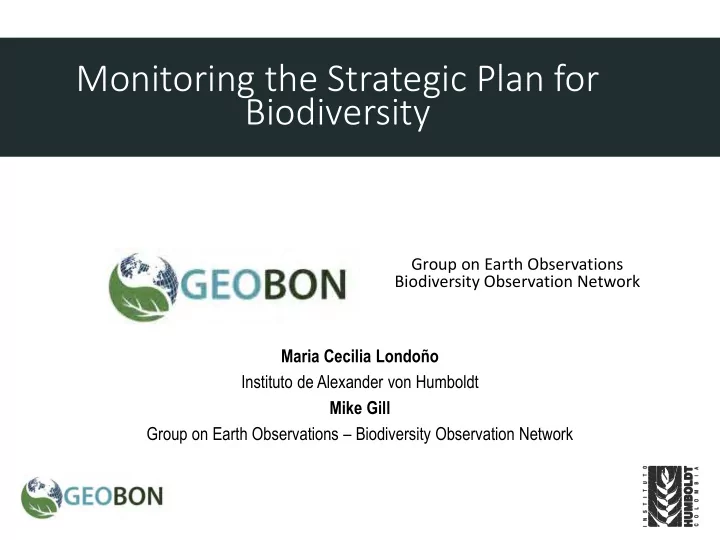

Monitoring the Strategic Plan for Biodiversity Group on Earth Observations Biodiversity Observation Network Maria Cecilia Londoño Instituto de Alexander von Humboldt Mike Gill Group on Earth Observations – Biodiversity Observation Network
A Global, Coordinated, What is Comprehensive and Sustained GEO? System of Observing Systems
What is Coordinated global network for improving GEOBON? biodiversity observations BON? Mission Visión Improve the acquisition, By 2025, GEO BON is a robust, coordination and delivery extensive and interoperable of biodiversity information biodiversity observation to users, particularly network covering the major decision-makers. biomes of the globe.
Connections to the CBD • GEO BON is user-driven , producing tools and products useful at the national scale • Specific focus on the CBD and the Strategic Plan for Biodiversity • GEO BON highlighted in a number of CBD Decisions : – Decision COP XI/3 (13) – continue work on the EBVs – SBSTTA Recommendation 17/1 – EBVs and BON in a Box – Decision COP XII/1 - invite parties & others to collaborate with GEO BON to build observation systems addressing priority needs. • SBSTTA19 Session3 – majority of statements pointed to the need for effective biodiversity observation systems
GEO BON Approach • Provide a robust, extensive and harmonized framework for biodiversity observations and systems that meet user needs • Top-Down: – Focus on a targeted set of variables (e.g. EBVs) and develop global observation frameworks (e.g. GWOS, GSEO, etc.) and products (biodiversity change indicators) • Bottom-Up: – Facilitate enhanced and new biodiversity observations through national and regional capacity building (e.g. national and regional BONs and BON in a Box)
Top Down: Essential Biodiversity Variables
Cover dimensions of biodiversity Pereira, H.M. et al (2013) Allow aggregation and disaggregation Science Ability to detect change
Essential Biodiversity Variables Pereira, H.M. et al (2013) Science
Challenges for monitoring biodiversity from in-situ measurements Personal bias Taxonomic dimension Reality Impact What do we currently Personal bias measure Spatial dimension Temporal dimension
Approaches for monitoring biodiversity from space Global Forest Change GLOBELAND30 University of Maryland-NASA National Geomatics Center of China Landsat based at 30 meter Landsat based at 30 meter resolution that looks at time series resolution with 10 classes for of forest cover loss from 2000 years 2000 and 2010 within a four to 2013 for every year year period
Global Biodiversity Observation Network: components • Spatially explicit • Improve our understanding of biodiversity change • Allows to connect local trends to regional and global trends
UNEP/CBD/ID/AHTEG/2015/INF/13
Global Biodiversity Change Indicators Global Ecosystem Restoration Index Miguel Fernández, Nestor Fernandez, Florian Wolf & Henrique Pereira
1 st Component Change in land productivity, from a functional perspective. Rain Use Efficiency (RUE defined as the ratio between NPP and PPT) PPT Climate Research Unit gridded dataset (CRU TS v. 3.23 ). NPP using MODIS NDVI as proxy Ecologically meaningful PPT NPP CRU TS3.21: July precipitation (PPT) for 1991-2000. Global Ecological Land Units
2 nd Component Change in energy balance. Non-evaporative fraction (energy partition between latent and sensible heat). MODIS temperature, albedo and vegetation Temperature Albedo Vegetation
3 rd Component Transitions in land cover. Forest to non-forest Global Forest Change University of Maryland-NASA Landsat based at 30 meter resolution that looks at time series of forest cover loss from 2000 to 2013 for every year
Water limited Atmospheric ecosystems decoupled ecosystems T1 C (Non-evaporative fraction) Energy balance T2 T1 D A T1 T2 T 2 B Energy limited T1 Atmospherically ecosystems coupled ecosystems Ecosystem productivity (Net Primary Productivity) Change captured by a transition in land cover Change not captured by a land cover transition Ecosystem restoration trajectory Ecosystem degradation trajectory Modified after Nemani & Running (1997), in Ecological Applications
Questions to: miguel.fernandez@idiv.de
Bottom-Up: BON in a Box
BON BOX in a BON-in-a-Box is a digital, customizable, ‘smart’ toolkit for biodiversity observations Purpose 3. Foster regional sharing of best practices 1. Serve as a technology transfer and technology; and, mechanism allowing access to the most 4. Advance i nteroperability – promote advanced and effective monitoring uptake of harmonized observations, data protocols, tools and software; management, analysis & reporting 2. Lower the threshold for a country to set through the use of consistent tools, up, enhance or harmonize a national protocols and data. biodiversity observing system. 5. Improve the power to detect & attribute biodiversity trends
Workshop Bolivia, Brasil, Colombia, Costa Rica, Ecuador, Abril 2015 Panamá, Perú, México
Framework for a National Biodiversity Information System Framwork design by Philip Bubb, UNEP World Conservation Monitoring Centre
TOOLS
Pick up the tools, to make up the observation system, or fulfill your need.
How do you find the tools you need in BON in a BOX?
GEO BON Working Groups
https://boninabox.geobon.org/ https://www.youtube.com/watch?v=i3CrrU9XlSo
THANKS!!!
Recommend
More recommend